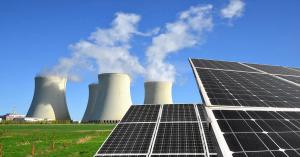U.S. Department of Energy Spends $325 Million to Support 15 Energy Storage Projects
U.S. spends heavily on energy storage projects to boost energy use
SAN FRANCISCO, USA, October 31, 2023 /EINPresswire.com/ -- The U.S. Department of Energy has announced a $325 million investment in the development of new batteries that convert solar and wind energy into stable 24-hour power, according to the Associated Press. The funds will be distributed to 15 projects in 17 states and to a Native American tribe in Minnesota.Source Article from https://www.state.gov/translations/portuguese/estados-unidos-anunciam-investimentos-fundamentais-durante-a-cimeira-do-clima- em-africa/
Batteries are increasingly being used to store excess renewable energy for later use when there is no sun or wind. The U.S. Department of Energy says these programs will protect more communities from blackouts and make energy more reliable and affordable.
Clean energy is booming in the U.S.
The U.S. now generates nearly 12 times as much solar power and 2.6 times as much wind power as it did in 2013, according to the seventh edition of U.S. Clean Energy's annual report, Renewables Rising 2023.
In 2022, nearly 17 percent of U.S. electricity comes from solar, wind, and geothermal energy. This is slightly more than 5 percent higher than in 2013. In 2022, 14 states will generate more than 30 percent of their total electricity from solar, wind, and geothermal energy, up from just two states in 2013.
This incredible growth will be key to realizing a vision for a clean energy future. In this vision of living a greener, healthier life in a world powered entirely by clean, renewable energy, renewable energy is on the rise.
U.S. Clean Energy Growth
Wind: By 2022, the U.S. will produce enough wind energy to power nearly 41 million average homes, 2.6 times the amount of wind energy available in 2013.
Solar: By 2022, the U.S. will produce enough solar energy to power nearly 19 million homes, almost 12 times as much as it did in 2013.
Electric Vehicle Sales: Americans buy more than 925,000 plug-in electric vehicles in 2022, more than 10 times the 2013 level.
Electric vehicle charging ports: more than 151,000 electric vehicle chargers nationwide, a nearly 18-fold increase from 2013.
Energy efficiency: energy efficiency improvements installed in 2021 will save 300 terawatt-hours of electricity over their lifetime, enough to power 28 million homes for a year.
Battery storage capacity: by the end of 2022, the U.S. will have 8.9 gigawatts (GW) of battery storage capacity, 60 times more than in 2013 and an 85 percent increase from the end of 2021.
Data source: https://environmentamerica.org/articles/renewables-are-on-the-rise-in-the-united-states/
For battery storage, the new money is for "long duration" storage, meaning it can last longer than the typical four hours of a lithium-ion battery. From sunset to sunrise, or storing energy for days at a time. Long-term battery storage is like a rainy day "energy storage account". Areas with rapid growth in solar and wind energy are often the most interested in long-duration storage. In the U.S., California, New York, and Hawaii are among those interested in this technology.
Here are some of the projects funded through the U.S. Department of Energy's Bipartisan Infrastructure Act of 2021:
-- A project led by Xcel Energy in partnership with long-term battery manufacturer Form Energy will deploy two 10 MW battery energy storage installations with 100 hours of use at the sites of shuttered coal power plants in Becker, Minnesota, and Pueblo, Colorado.
-- A project at California Valley Children's Hospital in Madera, an underserved community, will install a battery system to add reliability to an acute care medical center facing potential power outages from wildfires, floods, and heat waves. The project is being led by the California Energy Commission in partnership with Faraday Microgrid.
--The Second Life Smart Systems program in Georgia, California, South Carolina and Louisiana will use retired but still usable electric vehicle batteries to provide backup power for senior centers, affordable housing, and electric vehicle chargers. Backup power.
-Another project developed by battery diagnostics company Rejoule will also use retired EV batteries at three sites in Petaluma, California; Santa Fe, New Mexico; and a worker training center in Red Lake Country, not far from the Canadian border.
U.S. Undersecretary of Energy for Infrastructure David Klein said the funded projects will demonstrate that the technologies can work on a large scale, help utilities plan for long-duration energy storage, and begin to reduce costs. Cheap batteries will remove the biggest barrier to the renewable energy transition.
Source: https://www.whitehouse.gov/briefing-room/statements-releases/2021/11/06/fact-sheet-the-bipartisan-infrastructure-deal/
Accelerating: new U.S. PV growth to exceed 50% for the year!
According to Wood Mac's U.S. Solar Market Insights Report released on September 8, new PV installations in the U.S. will grow by more than 50% year-over-year in 2023, reaching another record high.
Report source: https://www.canarymedia.com/articles/solar/chart-solar-installations-set-to-break-global-us-records-in-2023
According to the report, the U.S. added 11.7GW (DC) of PV installations in the first half of 2023, a year-on-year increase of 37.7%, accounting for 45% of the U.S. grid's new generating capacity in the first half of this year.
Wood Mac believes that the U.S. could add 20GW of new PV in the second half of the year, equivalent to the total installed capacity for the whole of 2022. Despite a 13% decrease in new PV installations in 2022, 2023 will see a 52% year-over-year increase, with new installations reaching 32 GWdc.
The main bases include:
1. Uncertainty over outbreaks and anti-circumvention investigations in the first half of 2022 impacted total installations for the year.
2. In the second half of 2022, despite the confirmation of the tariff exemption for two years, the import time window period is reduced, and the ensuing stricter control of the products involved in the border has limited the new PV installations for the whole year.
3. In the first half of 2023, the finalization of the anti-circumvention investigation results, the U.S. PV module imports increased to 24.4GWdc, which is equivalent to the annual U.S. module shipments in 2022, plus the U.S. domestic PV module supply.
4. The introduction of the IRA Inflation Prevention Act will further stimulate the growth of local PV manufacturing and installed demand.
Unlike previous years, the champion of new PV installations in the first half of 2023 has also changed, with Florida replacing California as the top U.S. state with a total of 2.5GW of installations, and also becoming the new fast-growing utility solar market.
So the United States in the development and utilization of energy has long had its intentions and planning arrangements. From the point of view of annual statistics, the United States in the development and utilization of energy in this area of the cost of profit is still in positive growth, in a good stage. However, according to ZMS cable team observation, the United States is responsible for the energy-related government departments, and is not limited to focusing on wind and solar energy, earlier the concept of "geothermal energy", has been noticed by them.
The United States and the development of geothermal energy
American scientists have recently discovered an "inexhaustible" new energy source, which is hidden in the geothermal layer 20,000 meters below the earth's surface.
This energy is known as geothermal energy, and if successfully exploited, will be able to provide 2.3 billion years of clean energy for mankind, in the face of the depletion of oil and other traditional fossil fuels, geothermal energy is undoubtedly for mankind to ignite the flame of hope.
It can be used not only for power generation but also for heating, providing drinking water, and many other purposes. Now, the United States has invested 40 million dollars in geothermal energy development.
About the origin of geothermal energy
The earth is like a big, hot boiler that never goes out, filled with tumbling magma and heat flow, all of which originated during the earth's formation period, about 4.5 billion years ago, when the hot magma in the earth's inner core was full of vitality and destructive power, constantly erupting with boiling magma.
It was this primordial geothermal activity that nurtured the origin of life and provided the heat needed for the development of early human societies. Although the flames of the Earth's inner core have fallen silent, the deep mantle is still 2,000-4,000°C hot, and the outer core in the center is as high as 5,000°C.
These high-temperature regions continuously conduct heat into the surrounding underground water bodies, creating a rich geothermal resource. At the surface, the most obvious geothermal activity is concentrated in volcanic and fault zones.
To develop and utilize deep geothermal resources, modern drilling and surveying techniques, as well as materials and equipment that are resistant to high temperatures and pressures, are essential.
At present, the deepest geothermal drilling well in the world is only 12 kilometers deep, and it may take a long way to reach the ideal mining layer deep in the earth's crust, which may require a drilling depth of 20,000 meters.
Development and utilization of geothermal resources, not only can generate electricity but also can be widely used in home heating, greenhouse planting, tourism, etc., the Nordic countries have basically realized the full coverage of geothermal heating, Iceland is relying on geothermal power generation to solve the demand for more than 95% of electricity, Japan, the United States and other countries are also promoting the development and utilization of geothermal energy.
U.S. New Energy Policy Leads Companies Out of the "Valley of Death"
As the United States attempts to rapidly expand its renewable energy capacity, several major green companies are on the rise, as is the rest of the world. As the world undergoes a green transition, renewable energy startups have quickly emerged as major energy companies with the potential to compete with large oil and gas companies in the coming decades.
In the technology space, wind energy was the first technology that the U.S. government hoped to be able to promote, and its price is now at a very high level of competitiveness in the marketplace. The main reason for this outcome is because the U.S. energy market is very strong, especially overseas.
The second technology is the photovoltaic industry. Substantial technological progress has also been made in the photovoltaic industry. However, the realization of large-scale diffusion in the U.S. has been hampered by market expectations because the market is not very certain about the performance of PV technology. This has made it difficult for the country's PV technology companies to raise capital in the United States. However, for the PV can be successfully developed in the United States, there will still be unknown data, many entrepreneurs and investors are very optimistic about this.
ZMS Cable
ZMS Cable
+ +86 37167829333
email us here
Visit us on social media:
Facebook
Twitter
LinkedIn
YouTube
Other
The ZMS cable factory is making products for new cable orders.
Legal Disclaimer:
EIN Presswire provides this news content "as is" without warranty of any kind. We do not accept any responsibility or liability for the accuracy, content, images, videos, licenses, completeness, legality, or reliability of the information contained in this article. If you have any complaints or copyright issues related to this article, kindly contact the author above.





